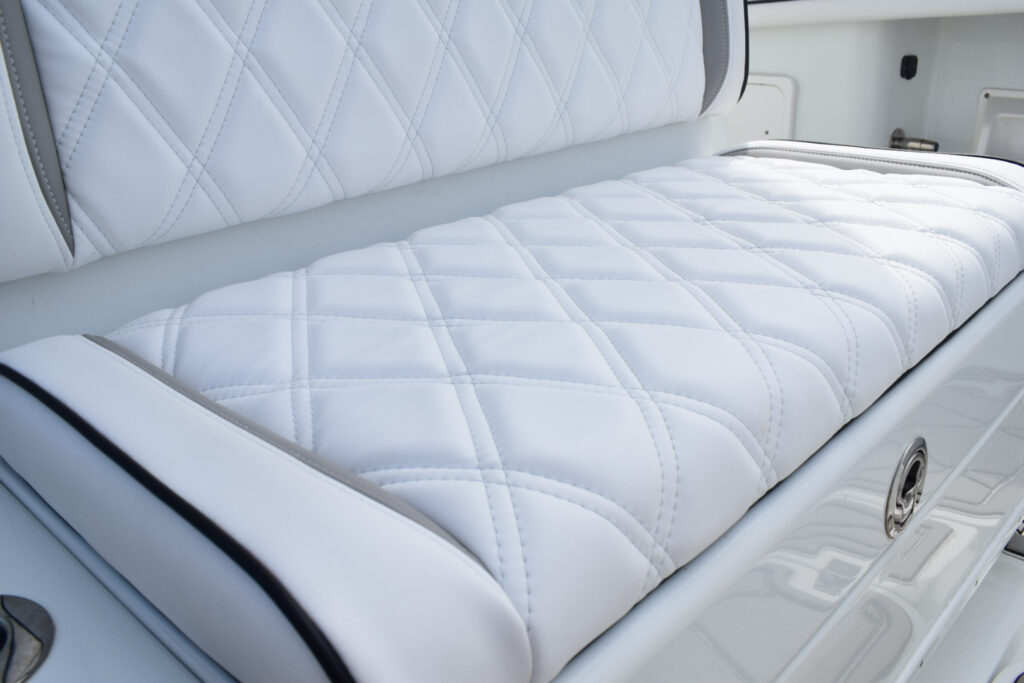Reupholster Boat Seats: A Comprehensive Guide

Boat seat upholstery is not just about aesthetics — it’s about preserving the value of your boat, maintaining comfort, and ensuring long-term durability in one of the harshest environments: the water. Over time, even the best marine seats start to show wear. Cracked vinyl, faded cushions, mildew spots, and flattening foam are all signs that it’s time to reupholster boat seats.
Why Reupholster Boat Seats?
Boat seats take a beating. Constant exposure to sun, water (fresh and salt), fluctuating temperatures, and regular wear from passengers cause materials to degrade. The average marine seat, depending on usage and climate, may only last 5–8 years before needing attention.

There are a few major reasons why reupholstering is worth considering:
- Improved appearance: Faded, torn, or stained seats make your boat look neglected.
- Enhanced comfort: New foam and fabric restore the comfort of the original seat.
- Increased resale value: A clean, updated interior makes a strong impression on potential buyers.
- Health and hygiene: Mold and mildew in seat foam can pose respiratory issues and smell unpleasant.
Signs It’s Time for an Upgrade
Not all upholstery damage is obvious. While cracks and discoloration are clear signs, some issues are less visible:
- Foam that feels hard, lumpy, or sunken
- Mold or mildew smells that linger even after cleaning
- Vinyl that feels brittle or sticky to the touch
- Seams that are pulling or tearing
If any of these apply, it’s likely time to reupholster boat seats before the damage worsens or spreads.
Choosing the Right Materials
Not all upholstery materials are created equal, especially for marine use. Here are key factors to consider when selecting replacement materials:
1. Fabric Type
The most common material used in marine environments is marine-grade vinyl. It’s designed to resist UV damage, mildew, and salt corrosion. High-quality vinyl feels soft and supple while remaining waterproof and durable.
For more upscale projects, solution-dyed acrylic fabrics (like Sunbrella) are used, particularly for indoor/outdoor or enclosed spaces. They offer a wider range of textures and are extremely fade-resistant.
2. Thread and Stitching
UV-resistant thread is a must — regular polyester or cotton thread will degrade quickly in sun and salt. Double-stitched seams and reinforced edges help prevent tearing and extend longevity.
3. Foam Type
Use closed-cell foam or marine foam that resists water absorption and dries quickly. High-density foams offer better support and will hold their shape longer under regular use.
DIY or Professional?
Some boat owners are tempted to tackle reupholstering as a weekend project. While basic bench seats or sun pads may be within reach for skilled DIYers, more complex jobs — like curved cushions, multi-panel backrests, or contoured helm chairs — typically require professional tools and techniques.
Professionals ensure:
- Seamless fit and finish
- Correct marine materials
- Proper foam shaping and attachment
- Longevity and weatherproofing
If precision, aesthetics, or resale value matters to you, it’s worth contacting a trusted upholstery shop that specializes in marine interiors. You can explore detailed options for materials, timelines, and finishes with reupholster boat seats experts.
What to Expect During the Process
Here’s a typical workflow for professional reupholstery:
- Assessment & Quote
The upholstery team inspects your seats and provides a breakdown of costs for materials, foam replacement, and labor. - Disassembly
Old covers are removed, and foam is inspected for mold or deterioration. - Cutting & Sewing
New vinyl is cut to fit and stitched using industrial sewing machines with UV-thread. - Foam Replacement (if needed)
New marine-grade foam is shaped and fitted. - Reassembly
Covers are installed, and seats are tested for fit, comfort, and finish. - Cleaning & Protection
Some shops apply protective treatments like anti-UV sprays or anti-microbial coatings.
The turnaround time for a full reupholstery job can range from a few days to a couple of weeks, depending on complexity and backlog.
Cost Breakdown
The cost to reupholster boat seats varies depending on size, design complexity, and materials used. Here’s a rough breakdown:
| Type of Seat | Estimated Cost (USD) |
|---|---|
| Small cushion | $100 – $200 |
| Helm chair | $300 – $500 |
| Back-to-back seat | $600 – $800 |
| Full sun pad | $800 – $1200 |
| Complete set (cockpit) | $2,000 – $5,000+ |



